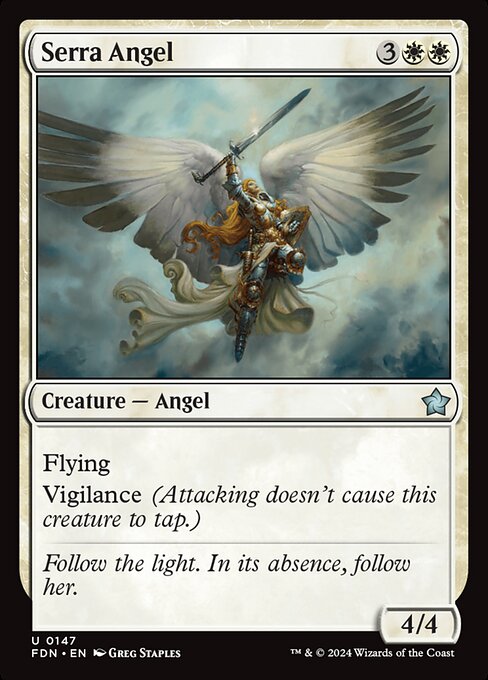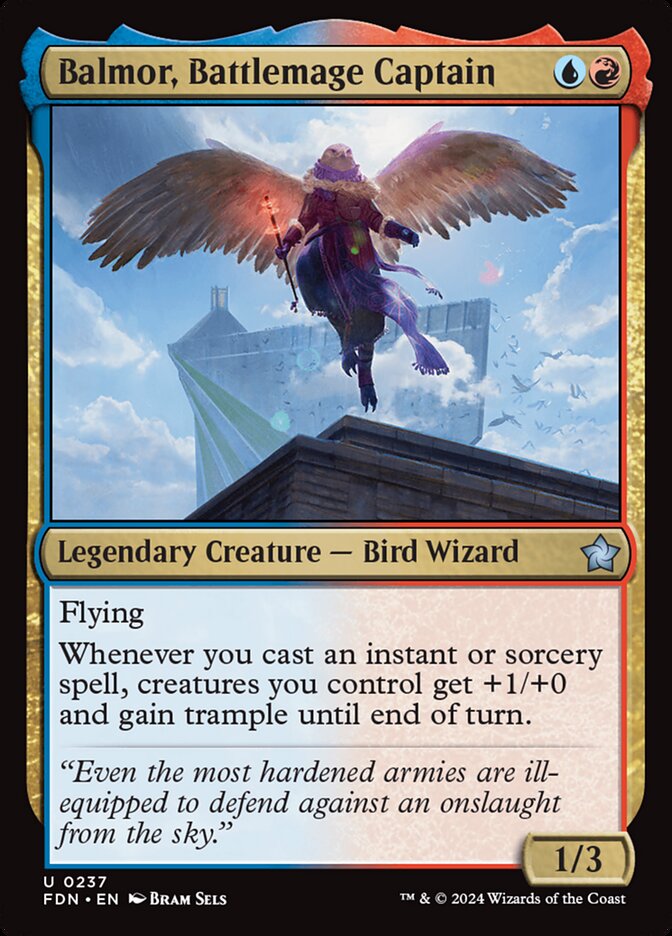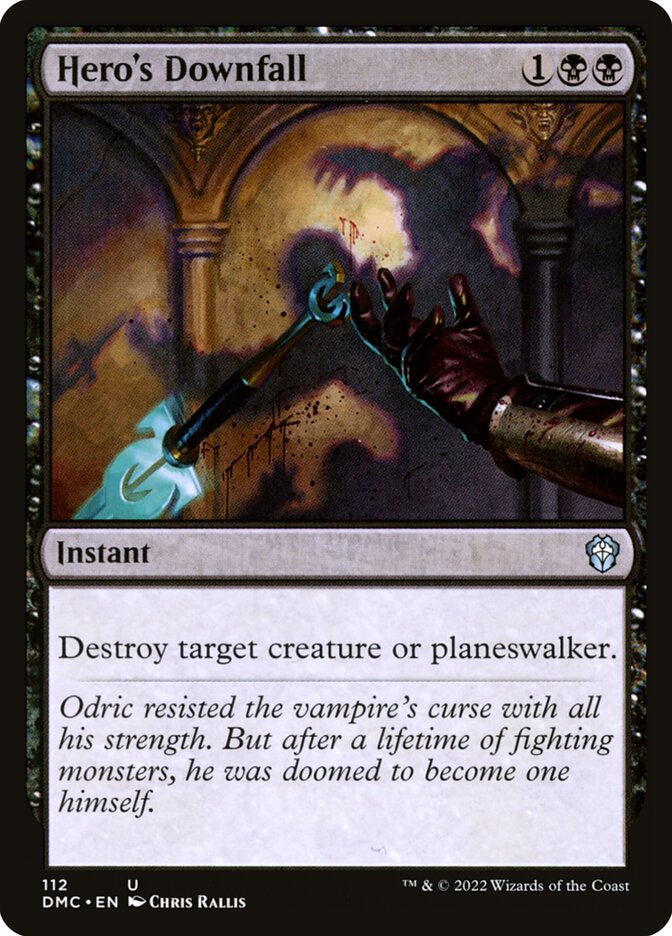Once upon a time (and skip this section if you’ve heard this story before), Wizards of the Coast released yearly Core sets that served two primary purposes. They gave new players a good place to get started. And they provided much needed reprints. Tragically, these Core sets were not as popular as other Magic expansions, and eventually they were abandoned into the dustbin of history.
However experienced Magic players know that the graveyard is a resource, and the Core set concept has returned with Foundations. This set serves the function of a Core set - except it will stay in print and remain legal for at least five years (and maybe more). Of course, that detail is irrelevant to Limited players; what’s important is that there were Core sets that provided incredible draft environments. How is FDN shaping up in that respect? Let’s take a look and see!
Mechanics and Themes
FDN has no new mechanics; however it does bring back several of Magic’s most popular ones! Note that there are some additional keywords sprinkled through the set, most notably Threshold and Morbid and Landfall; however, their usage is limited to their associated two color archetype, and they are discussed in the next section.
Flashback


A card with Flashback can be cast again from the graveyard for its Flashback cost. Afterwards, it’s exiled (preventing the card from being repeatedly cast forever). The benefit is obvious: it’s two spells in one card. However, there are some subtleties to evaluating and playing these cards. For example, Think Twice essentially lets you draw two cards for five mana - a terrible rate! But people who have played with this spell before know that the option to split that five mana across multiple turns makes the card much better than it looks. Bulk Up presents a different evaluation angle. Its Flashback cost of six feels ridiculous for its mediocre effect. But its initial cost of two is far more reasonable, and having the option to cast it later - even for an excessive amount of mana - is surprisingly useful.
Raid


A card with Raid checks if you’ve attacked earlier in the turn. If you have, then their Raid ability triggers and you get a nice little effect. Often these effects are stapled onto a creature’s “enters” ability; for example, Skyship Buccaneer gives you a card if you Raid, ensuring that you get some value even if the attack was not in your favor. On the other hand, Midnight Snack just sits on the board and activates any turn that you go on the offense, slowly building up your Food stores until you’re ready to use it to drain your opponent out. The commonality? You’ll want to attack, so make sure you have combat tricks or - better yet - evasion to push your creatures through.
Kicker


A spell with Kicker nets you an added bonus if you pay the Kicker cost while casting it. That bonus will vary; for example, Sun-Blessed Healer will grant you a minor reanimation effect, while Grow from the Ashes allows you to ramp out two lands instead of just one. The temptation will be to always wait until you can pay the Kicker cost. However, there’ll be times where it’s better not to - for example, if you need a two drop, or really want to ramp on turn three. Recognizing those situations is key to using Kicker spells effectively.
Archetypes
The archetypes of FDN are not the flashiest or the most complex. You won’t see unique strategies such as Duskmourn’s Blue/Red Rooms or Bloomburrow’s Green/Blue self-bounce. Rather, think of the stereotypical strategy you associate with a given color pair… and that’s probably what it’ll be. But just because an archetype is expected doesn’t mean it can’t also be powerful or subtle or fun!
As is now standard, each two color archetype is represented by a signature uncommon.
White / Blue: Fliers



Flying is a mechanic that many Magic players take for granted; after all, it’s in every set. But the reason why it’s in every set is simply because it’s so good at creating secondary tensions and sub-games on the battlefield. As is traditional, the archetype that features flyers in FDN is White/Blue. The strategy is personified by the reprinted Empyrean Eagle, whose simple text belies the fact that its mere presence can end a game very very very quickly. There will be some variations to a White/Blue deck, however. The White half leans more on more expensive and powerful threats such as the iconic Serra Angel. The Blue half is less straightforward, with devious cards such as Faebloom Trick that generates tiny threats while tying one of your opponent’s creatures down. Lean towards one side or the other - or find the perfect path through the middle.
White / Black: Lifegain



In Magic life is just a resource, and gaining life is not an efficient way to win the game - unless you have cards that explicitly ease your way towards doing so. For that reason, you should consider FDN’s White/Black lifegain archetype to be a combo archetype that requires you to play several different pieces. You’ll need a source of lifegain, such as Dazzling Angel. You’ll want a payoff, such as the one granted by Marauding Blight-Priest. And you’ll want redundancy, which Fiendish Panda provides in a variety of ways: an alternate payoff in the form of a rapidly growing monster, and a way to retrieve any combo creatures that may have tragically ended up in your graveyard. Put all these pieces together and you’ll assemble a resilient deck that’s very hard to beat.
Blue / Black: Threshold



Blue/Black is often a subtle archetype, but the trio of Dreadwing Scavenger, Cephalid Inkmage, and Billowing Shriekmass take a lot of mystery out of the strategy. All three of these creatures enable Threshold by allowing you to dump things into your graveyard; all three of them gain a nice little bonus once Threshold is reached. So what’s the complication? It’s that these cards by themselves are unlikely to win you the game; they’re just too slow to compete with aggressive linear strategies. The key to this archetype is the cards you draft besides the obvious ones - everything from Blue tempo or Black removal spells, to card advantage effects to ensure you can run your opponent out of steam (and Flashback spells synergize particularly nicely with the archetype’s self-mill effects). If constructed well, a Blue/Black deck will have a sense of consistency and inevitability that allows it to defeat any deck out there.
Blue / Red: Instants and Sorceries ( Aggro )



There are two flavors of a Limited “instants and sorceries” archetype. One is slow and controlling, and the other is all-out aggressive. Reading the text of Balmor, Battlemage Captain tells you that the Blue/Red deck favors the latter version in FDN: play it alongside a bunch of cheap creatures, then let a wave of instants and sorceries sweep you to victory. Sometimes it may not be quite so simple, however; sometimes your opponent will be able to withstand your initial flurry and stabilize the board. That’s when you’ll want an alternative plan. Firespitter Whelp provides one as an evasive threat that also gradually pings your opponent to death. Tolarian Terror is another: drop a couple of these for one or two mana, and watch how quickly your opponent folds.
Black / Red: Raid



Magic is a game that rewards you for attacking by allowing you to, you know, win the game. But sometimes your opponent might be difficult by playing silly things like blockers, and that’s when you have to ask: is it possible to be rewarded more for attacking? Well if you play Black/Red in FDN, the answer is “yes”, thanks to the wonderful Raid mechanic that… rewards you for attacking. Perforating Artist is a particularly deadly example of this, with its soul-sucking ability that forces your opponent to make very difficult decisions. There are other possible benefits as well, such as Gutless Plunderer’s deck filtering. But what happens if your opponent has big blockers? Well, deathtouch guarantees that you’ll trade creatures at the worst; alternatively Gorehorn Raider allows you to snipe away a small creature (or one that’s already taken damage). Find ways to keep your attacks going, and you’ll wear down your opponent in short order.
Black / Green: Morbid



It’s a sad truth, but death is a part of Magic. If you’re willing to embrace that fact, then Black/Green might be the archetype for you! Wardens of the Cycle grants you a really nice card draw benefit for sending creatures to a graveyard during your turn (and I guess you can gain life instead if you really need to). You’ll find other varied Morbid effects in FDN; for example, Cackling Prowler foregoes card advantage for raw power. The question then becomes: how can you consistently trigger Morbid? Oftentimes, it’ll just happen through the natural ebb and flow of combat. But if you need to force the issue, just grab Vampire Gourmand and start sacrificing your own creatures; the card draw part of the creature’s ability means you won’t be losing card advantage by doing so. Grind your opponent through a constant cycle of life and death, and you’ll wear away their resources until you’re the only one left standing.
Red / White: Go Wide (Aggro)



There’s not a lot to say about Red/White in FDN. Go wide with lots of creatures (Heroic Reinforcements and Goblin Surprise both do the trick), and buff them up before you attack (Heroic Reinforcements and Dauntless Veteran are particularly effective in doing so). Done correctly, you’ll create unceasing waves of attackers that will steadily whittle down your opponent’s life total - or take away big chunks at a time. Keep your opponent off balance, and you’ll knock them over before they manage to find their footing.
Red / Green: Power



Big creatures go smash, and sometimes that’s all you need to know in order to win a game of Magic. Ashroot Animist personifies this strategy: a 4/4 with trample that also gives another creature an increase in power and trample. Swing with it a couple of times (maybe adding in a buff spell or two), and you’ll probably win the game. Sadly, things aren’t always so simple. You also need early drops to survive the early game; Courageous Goblin is an excellent one, since it becomes stronger once you play your more powerful creatures. And sometimes you need some resiliency if your opponent picks off your key attackers. Garruk’s Uprising gives you exactly that by providing both a card draw engine and a trample buff for all your big creatures. That combination is likely enough to allow you to keep pumping out threats and smashing them into your opponent until they fall over dead.
Green / White: +1/+1 Counters



Green/White is another “big creature” archetype, only this strategy counts upon nurturing your smaller creatures until they become all grown up (through +1/+1 counters). Good-Fortune Unicorn accelerates this process by giving all your other creatures a +1/+1 counter as soon as they enter the battlefield, but there’s no harm in waiting a little bit and buffing your creatures afterwards with a card like Felidar Savior. Build your deck properly, and you’ll end up with a powerful force - and if you still need to find a way to end the game, cast Gnarlid Colony and let your creatures trample all over your opponent’s life total.
Green / Blue: Landfall



If you played Dominaria Limited, I’m guessing you probably twitched as soon as you saw Tatyova, Benthic Druid pop up here. This merfolk is an insane value engine; trigger her Landfall ability just once, and you’ll feel like you can’t lose. Elfsworn Giant and Grappling Kraken have Landfall abilities that are maybe a little worse, but they’ll still make your opponent sigh with each of your successive land drops - after all, an army of 1/1 elves is excellent at gumming up the board, and a repeatable stun effect is a good way to slow down your opponent (or simply win). But if you play this archetype, don’t forget that the true value of playing a mass of lands is… being able to tap for a lot of mana. Sprinkle in high mana value cards and permanents with expensive activated abilities, and you’ll find yourself spending your way to victory.
Key Commons and Uncommons
White
Creatures



Cat Collector: This card is only amazing if you can consistently gain life - but there are lots of ways to do so.
Dawnwing Marshal: This is an incredible rate for a flier, and its activated ability will become increasingly dangerous as the game goes on.
Inspiring Paladin: Well, this creature is a pain in the butt to block - and it has the ability to make other creatures a pain in the butt to block as well.
Noncreatures



Banishing Light: Yep, it’s been reprinted a bunch; yep, it’s still good.
Divine Resilience: A well-timed cheap White protection spell can win you the game; this one gives you the additional option to save your entire board.
Joust Through: No, this isn’t Lightning Bolt; yes, it’ll take care of almost any creature in the first few turns of the game.
Blue
Creatures



Bigfin Bouncer: That’s the troll grin of someone who knows that they’re making their opponent’s life very difficult.
Grappling Kraken: This creature simply wins games.
Mischievous Mystic: It’ll take a little work to consistently pump our Faeries - but if you’re playing Blue it won’t take that much work.
Noncreatures



Aetherize: This isn’t a board wipe - but it is a mass tempo effect that can irretrievably swing the board in your favor.
Fleeting Distraction: A one mana cantrip is great in a set full of “instants and sorceries matter” cards, and this one will occasionally let you win in combat to boot.
Witness Protection: Blue’s aura-based removal has its drawbacks, but only costing one mana makes up for a lort.
Black
Creatures



Arbiter of Woe: At the end of all its text is the realization that, yes, this card gives you card advantage.
Tragic Banshee: It’s not difficult to turn this into a five mana removal spell that also gives you a 5/3 creature.
Vampire Nighthawk: Flying! Lifelink! Deathtouch!
Noncreatures



Eaten Alive: There’s a variety of situations where you’ll actively want one of your creatures to die. This spell does that while exiling an opponent’s creature as well!
Hero‘s Downfall: Shockingly, unconditional instant-speed removal is still good.
Stab: You may think that this only kills small creatures - but play this in the middle of combat and you’ll see how versatile this really is.
Red
Creatures



Battlesong Berseker: This is how you make all of your creatures really difficult to block. Note that it doesn’t have to attack to grant you its bonus.
Slumbering Cerberus: Yeah, maybe you won’t always be unable to untap it. But if you’re playing aggro then chances are that you will.
Strongbox Raider: Not quite card draw, but close enough.
Noncreatures



Abrade: This instant was good back in Hour of Devastation, and I don’t see any reason why it wouldn’t remain good now.
Burst Lightning: Shock, but better.
Sure Strike: Most of the time this instant will help you win combat; once in a while it’ll enable you to win the game.
Green
Creatures



Affectionate Indrik: It won’t always be a 2-for-1, but most of the time it will be.
Apothecary Stomper: Most of the time it’ll be a 6/6 for six mana, and sometimes it’ll gain you some critical life.
Needletooth Pack: Wait, you can put the counters on any creature you control?
Non-Creatures



Bite Down: It’s effective. Not much else to say.
Overrun: Five mana sorceries aren’t usually all that remarkable, but this one will flat out win you the game.
Snakeskin Veil: Green’s big creatures attract removal spells; this trick will keep them alive.
Other Cards to Know
Mana Fixing
The full cycle of tapped lifegain lands is reprinted in FDN. Half of the Play Booster packs will contain one of these lands (instead of a basic land).


There are additional colorless options for mana fixing, although some are considerably more efficient than others:




Of course, Green has even more mana fixing capabilities:


Overall? Mana fixing is good (but not great). Three color mana bases won’t fall into your lap, but you’ll be able to make them work if you try hard enough.
Creatures with Reach
Arena now has a nifty (and obvious) animation that indicates if a creature has reach; much to my embarrassment, I have nevertheless had a flyer eaten by a reach creature more than once.



There’s not that many - and notably, for the first time in a while, Red has no creatures with Reach! As a result, you may need to look for alternative ways to deal with fliers.
Summation
So what should you know about Foundations?
In FDN, colors do what you think they do. White has small creatures and mass pump spells, Blue has ample instants and sorceries as well as control elements, etc. If you’ve played Magic even semi-regularly, you won’t be surprised by how any of the colors - and two color archetypes - play.
As a result, FDN will feel less complex than recent Limited sets - but there’s still plenty of ways to play around! Notably, there are strong synergies between neighboring color pairs, and mana fixing is available (if not ample).
I rarely (heh) mention rares, but it’s worth mentioning that they nearly all of them feel like they have strengths that fit neatly into their colors or color pairs. As a result, I expect the Limited format to lean towards these unique and powerful cards.
Good luck!










